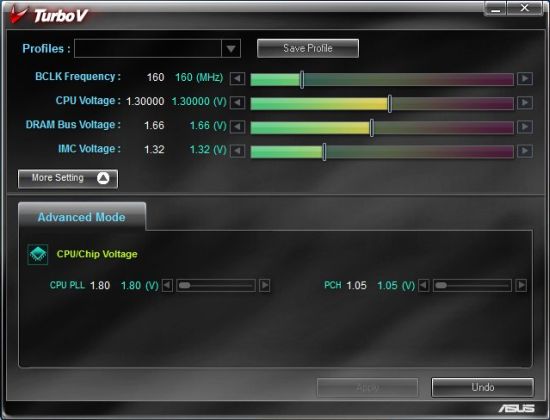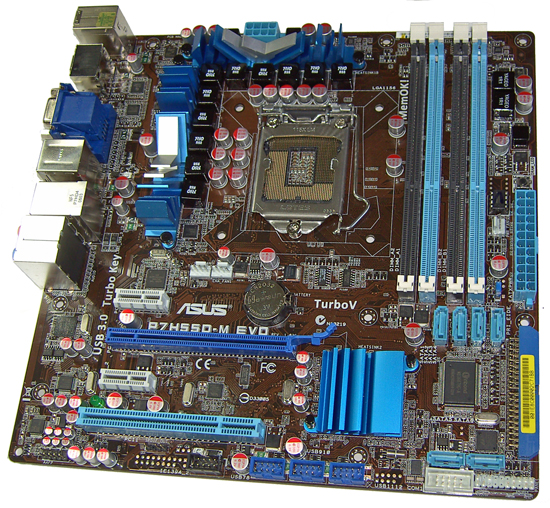Choosing the Best H55/H57 Motherboard - Part 1
by Rajinder Gill on January 31, 2010 11:30 PM EST- Posted in
- Motherboards
ASUS P7H55D-M EVO
The ASUS P7H55D-M EVO is currently priced at $135 at Newegg.
| ASUS H55D-M EVO | |
| Market Segment | H55 General Use/HTPC |
| CPU Interface | LGA-1156 |
| CPU Support | LGA-1156 i3/i5/i7 Series of Processors |
| Chipset | Intel H55 Express Chipset |
| BCLK Speeds | 80-500MHz in 1MHz increments |
| DDR3 Memory Speed | 800, 1067, 1333 Frequency Ratios |
| QPI Frequency | All supported mutlpier ratios available |
| Core Voltage | 0.85V ~ 1.70V in 0.00625V increments |
| CPU Vdroop Compensation | On/Off |
| CPU Clock Multiplier | Dependant on Processor, all available multipliers supported |
| DRAM Voltage DDR3 | Auto, 1.20V ~ 2.20V in 0.02V increments (1.50V base) |
| DRAM Timing Control | tCL, tRCD, tRP, tRAS, + 15 Additional Timings |
| DRAM Command Rate | Auto, 1N, 2N and 3N |
| PCH Voltage | Auto, 1.05V ~ 2V in .01V increments, 1.05V Base |
| CPU VTT (Uncore) Voltage | 1.1V ~ 1.90V in 0.02V increments |
| CPU PLL Voltage | 1.8V ~ 2.2V in 0.02V increments, 1.80V Base |
| Memory Slots | Four 240-pin DDR3 DIMM Slots Dual-Channel Configuration Regular Unbuffered DDR3 Memory to 8GB Total |
| Expansion Slots | 1X PCIe 2.0 16X Slot 2x PCIe X1 slots 1 X PCI slot |
| Onboard SATA/RAID | 6x SATA 3.0Gbps Ports - Intel Chipset Marvell 88SE6111 SATA and PATA Controller 1X Ultra DMA 133/100/66 for up to 2 PATA devices 1 X External SATA 3.0 Gb/s port |
| Onboard USB 2.0 | 10 USB 2.0 ports (4) I/O Panel, 6 via brackets 2 X USB 3.0 connectors on rear I/O (NEC USB 3.0 controller) |
| Onboard LAN | Realtek 8112L Gigabit LAN (PCI/e) |
| Onboard Audio | Realtek ALC889 High Definition Audio Codec, 7.1 Channel. |
| Other Onboard Connectors | 1X FPA, 1X 1394, 1X COM, 1X S/PDIF |
| Power Connectors | ATX 24-pin, 8-pin EPS 12V |
| I/O Panel | 1 x PS/2 Keyboard 1 x RJ45 4 x USB 2.0/1.1 1 x eSATA 2 x USB 3.0 1 x Optical Toslink 1 x HDMI 1 x RGB 6 Audio I/O jacks |
| Fan Headers | 1 CPU + 2 Additional Headers |
| Fan Control | Full temp/speed fan control for CPU header via BIOS or OS software Additional headers have 3 step speed control via BIOS or OS software |
| Package Contents | 2X SATA cables, 1 X UDMA cable, User Guide, 1 X Q-Connector, 1 X Driver/software DVD, 1 X I/O Shield. |
| Board/BIOS Revisions Used | Board Rev: 1.03G BIOS Files Used: 0503 and 0701 |
| Form Factor | uATX (9.6 in. X 9.6 in.) |
| Warranty | 3 Year Standard |
The P7H55D-M EVO package contents include: two SATA cables, one UDMA cable, User Guide, one Q-Connector, Driver/software DVD, and I/O Shield. That's a little light on SATA cables for our liking; a couple of extra would have been nice, as would the inclusion of a USB bracket to make use of the internal headers.
On the hardware front you get standard Realtek ALC889 audio, Realtek 8112L PCI-E LAN, two 1394 ports (VIA VT6308P), and two USB 3.0 ports thanks to the inclusion of NEC's controller chip. Unlike MSI and ASRock you don't get a TPM header; we're not sure what the uptake for this technology is right now, but it's something to bear in mind if you have plans to make use of it in the future.
Software
ASUS's driver DVD comes bundled with a slew of tools: PC Probe for software/temp monitoring, AI Suite/Fan Expert for setting up fan profiles, Express Gate for a quick-boot Linux environment, and Turbo-V for overclocking.

Turbo-V is a simple OS-based tool that allows on-the-fly changes to bus speeds and voltages, as well as offering the option to save profiles. A GPU level driver is also included, which allows for overclocking the IGP within the OS. We found the supplied version of Turbo-V to be fully functional with our 661 Clarkdale in testing. Out of the three vendors on test here today, ASUS seems to have come the closest to getting things working right first time.
The Board

Slot layout on the P7H55D-M EVO is good, although there's only one full length PCI-E x16 slot limiting upgrade options for add-in RAID cards if you go with a discrete GPU. Instead, ASUS offers two PCI-E x1 slots, with one placed to be accessible regardless of slot loading. The IDE port could have been left out, although you still get six accessible SATA ports at the lower right corner for the board in spite of its presence.
Three onboard fan headers are on offer. Fan control is not very comprehensive for the power and chassis fan headers; you get a three-step control, which can be applied to ramp dynamically via software profiles. You don't get any onboard power buttons either, barring Mem-OK, which acts as a solution to most non-boot situations related to overclocking.
Onboard cooling is more than adequate to take care of most overclocking. If you do overclock your Clarkdale CPU over 4GHz, some air cross-flow over the PWM heatsinks will keep them cool enough under normal usage. Heatsink height is low, so the board caters for a variety of CPU cooler installations without orientation issues - unless you install memory modules with very tall heat spreaders in the primary DIMM slots, which can make things a little tight for fan placement.
Overclocking

4GB memory overclocking is not class leading; use the 2:10 memory ratio and you'll find you're limited to around 175 BCLK (DDR3-1750). The alternative is to stick with 2:8 (DDR3-1600MHZ) at around 200 BCLK with a CAS of 6 or 7, modules permitting. The bonus to this configuration is you get to keep a reasonable QPI multiplier ratio, thus delivering reasonable performance.
Moving up to 8GB, you're looking at being capped at DDR3-1550~1580 unless you relax the QPI multiplier ratio, which does not really make sense from a performance standpoint. Real world differences are of course small either way, but we aim to take whatever we can get from the chipset.
BIOS
BIOS 0701 is the comprehensive functionality and overclocking release from ASUS. You get the full array of DRAM timing options included from tRD register manipulation to fine control of voltage rails. DRAM timing adjustments are easy to make because the BIOS shows you every setting value when you select AUTO mode for the timings, giving you a base to work from. You can change one setting at a time while leaving all others on AUTO and it's simple to change something back if things go wrong. MSI would do well to learn something from this approach.
Voltage adjustments can be made easily too; you can type the voltage value in directly and the board will select the nearest offset. The ranges are quite granular so there's plenty of room for fine-tuning.
There are eight BIOS save locations available for profiles, which come in handy during initial setup or overclocking adventures. A built-in BIOS flashing routine is also provided, allowing easy updates from a USB pen drive or from a HDD.





















56 Comments
View All Comments
crochat - Wednesday, February 3, 2010 - link
In my opinion testing H5X boards should focus on IGP. Isn't that the aim of the chipset to use CPUs with IGP? Instead of the gaming benchmarks I'd be much more interested in multimedia and peripheral (firewire, esata, usb, networking) performance.Regards
thorgal73 - Tuesday, February 2, 2010 - link
Just to let you know, Massman found the solution to the IGP overclocking problem :http://www.madshrimps.be/?action=getarticle&ar...">http://www.madshrimps.be/?action=getarticle&ar...
Cheers!
Rajinder Gill - Tuesday, February 2, 2010 - link
Thanks for the link.That actually makes a lot of sense and explains the extra IGP voltage you have to pump - even though BIOS shows a fixed IGP freqeuncy.
Probably a good idea just to make it into an Excel calc so people can use it easily.
http://www.mediafire.com/file/2go0yotyz5z/quick">http://www.mediafire.com/file/2go0yotyz5z/quick igp calc.xlsx
later
Raja
Rajinder Gill - Tuesday, February 2, 2010 - link
This one's a bit better, easy to work out the required BCLK for and equivalent IGP frequency at various IGP multiplier ratios.http://www.mediafire.com/file/nhfnnedgzwb/quick">http://www.mediafire.com/file/nhfnnedgzwb/quick igp calc.xlsx
yuhong - Monday, February 1, 2010 - link
"If you're going to use the IGP, you don't really need the extra PCI-E lanes, which essentially means that you're paying for the option to run RAID on the H57 PCH. "Well, USB 3.0 and SATA 6GBps takes 4 PCIe lanes.
Rajinder Gill - Monday, February 1, 2010 - link
You're looking at $200 boards that offer both SATA 6G and USB 3.0 in tandem unfortunately. USB 3.0 can be had under $130, with enough PCI/e left over for upgrading IMO.Nataku - Monday, February 1, 2010 - link
Just wondering (may be I'm just being dumb)Do you know if any or all of the h55 boards support dual screen?
I've been wanting to build a HTPC and dual screen it with my TV and a touch screen, but wasn't sure if the video out can actually work in dual screen mode.(ran into one that only ran in clone long ago =.=)
Also, this is off topic but, will you guys be making some reviews on touch screen monitors? HP and Dell are selling 20"+ touchscreens at around 300CAD but Firebox and Elo are selling 15" at 4~500CAD. Just curious how that part of the industry are coming along (20" too big imo to be beside a TV...)
Rajinder Gill - Monday, February 1, 2010 - link
Hi,Yes, dual display options are offered as part of Intel's drivers for the IGP. So you should be able to setup both options. I've tried with DVI and HDMI outputs simultaneously and it recognises both fine and allows you to set them up.
Jarred's the guy for monitors and such, so I'll pass the info over to him.
Hope this helps..
Raja
Nataku - Thursday, February 4, 2010 - link
Thanks :)Rick83 - Monday, February 1, 2010 - link
I am currently looking to upgrade my server and the savings from replacing the old nv 6200 with on-chip graphics are attractive.Now, normally this would be a done decision, but I am planning on running quite a few drives in that box, 14 to be precise. Currently I have one RAID 5, one RAID 1, one root disk and one optical drive, I will add another RAID 5 and another RAID 1 as part of the upgrade. All except 5 drives are attached via SATA. I already have an IDE-controller installed via PCI, but I'd like to avoid installing an extra SATA controller, as it seems much cheaper to just go for a board with 10x SATA on board.
But due to my use of full-disk encryption, I'd really like to be able to access AES-NI, so it will have to be a clarksdale i5. There are P55 boards with 10 SATA ports, and X58 boards too, but I'd really like to go with the on-chip graphics, both to save what little pci-e I have on these boards, as well as to save the space and energy.
Does anyone reasonably expect Asus or Gigabyte or MSI (as those are the usual suspects for 10x SATA) to release such a board based on H5x? If not, I'd best grab an old Gigabyte P55 UD5 soon...